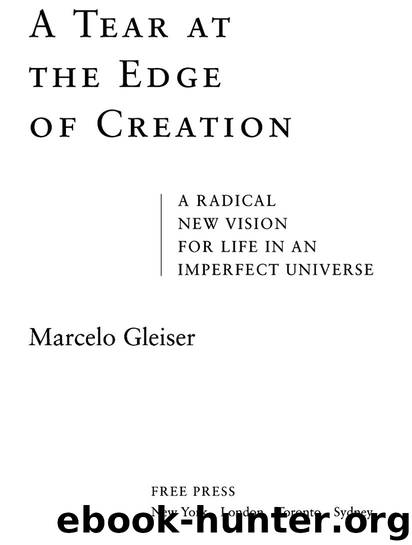A Tear at the Edge of Creation by Marcelo Gleiser

Author:Marcelo Gleiser
Language: eng
Format: epub
Publisher: Free Press
Published: 2010-07-15T00:00:00+00:00
35
UNIFICATION: A CRITIQUE
From Thales to Kepler to Einstein to superstrings, the quest for the Final Truth has inspired some of the greatest minds in history. Although superstring theory is a work in progress, and may be for hundreds of years, the quest has so far failed. True, some partial unifications have been achieved. We mentioned how electricity and magnetism behave as a single wave propagating across space at the speed of light. We also mentioned how the absence of magnetic monopoles spoils the perfection of this unification, although we can still treat electromagnetism as one interaction. We have seen how the weak interactions violate a series of internal symmetries: charge conjugation, parity, and even the combination of the two. The consequences of these violations are deeply related to our existence: they set the arrow of time at the microscopic level, providing a viable mechanism to generate the excess of matter over antimatter. Without these asymmetries, the universe would be filled with a soup of radiation and a few sparse particles: no atoms, no stars, no people. The message from modern particle physics and cosmology is clear: we are the products of imperfections in Nature. Even if, to the accuracy of our measurements, other symmetries are indeed respected—energy conservation, electric charge—we still must face the fact that many aren’t, or that they hold only as approximations. Asymmetries are the links to our origins.
Grand Unified Theories make two important predictions: the proton should be unstable and decay, and there should be new types of magnetic monopoles, heavy cousins of the simpler electromagnetic ones. After decades of searches in laboratories across the globe, no proton has decayed and no magnetic monopole has been detected. We can always say that one day they will, that our present models are too simplistic and our detectors not sensitive enough. In the case of GUT monopoles, cosmic inflation can get rid of them, essentially keeping only one or a few within our observable Universe. Still, as time passes and increasingly accurate experiments force the models into an ever-shrinking gap, it’s hard not to feel that something may be very wrong with the whole picture.
Then there is electroweak unification, our only model where two forces do behave similarly above a certain energy threshold and experimental data confirms some of its main predictions. There is no question that the theory is a triumph of modern physics; we already have sung its praises. But a careful look at the details shows that the electroweak unification is not a true unification. At least not in the sense of grand unification, which predicts that all forces become one. The electroweak theory never truly gets rid of the difference between electromagnetism and the weak interactions. The neutral-force-carrying particles we identify with the massless photon and with the heavy Z 0 at low energies are mixtures of the gauge bosons of the high-energy theory. 17 Furthermore, the left-handedness of the neutrino makes the theory lopsided: to be consistent with experiments, right-handed particles are described very differently from their left-handed counterparts.
Download
This site does not store any files on its server. We only index and link to content provided by other sites. Please contact the content providers to delete copyright contents if any and email us, we'll remove relevant links or contents immediately.
The Complete Stick Figure Physics Tutorials by Allen Sarah(7338)
Secrets of Antigravity Propulsion: Tesla, UFOs, and Classified Aerospace Technology by Ph.D. Paul A. Laviolette(5333)
Thing Explainer by Randall Munroe(3910)
The River of Consciousness by Oliver Sacks(3572)
The Order of Time by Carlo Rovelli(3162)
How To by Randall Munroe(3074)
A Brief History of Time by Stephen Hawking(2992)
I Live in the Future & Here's How It Works by Nick Bilton(2960)
What If?: Serious Scientific Answers to Absurd Hypothetical Questions by Randall Munroe(2668)
The Great Unknown by Marcus du Sautoy(2662)
Midnight in Chernobyl by Adam Higginbotham(2516)
Blockchain: Ultimate Step By Step Guide To Understanding Blockchain Technology, Bitcoin Creation, and the future of Money (Novice to Expert) by Keizer Söze(2467)
Networks: An Introduction by Newman Mark(2382)
The Meaning of it All by Richard Feynman(2319)
Easy Electronics by Charles Platt(2308)
The Tao of Physics by Fritjof Capra(2247)
Midnight in Chernobyl: The Untold Story of the World's Greatest Nuclear Disaster by Adam Higginbotham(2196)
When by Daniel H Pink(2098)
Introducing Relativity by Bruce Bassett(2097)
